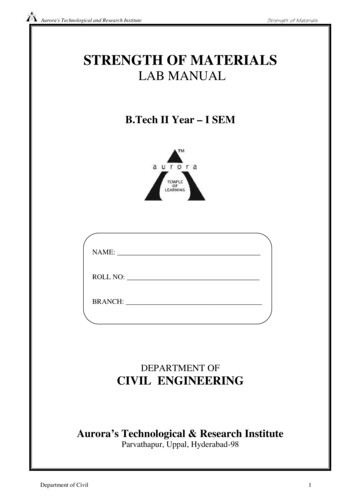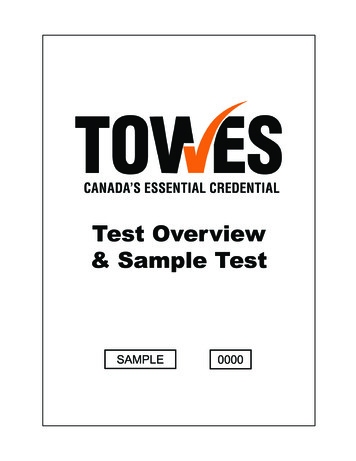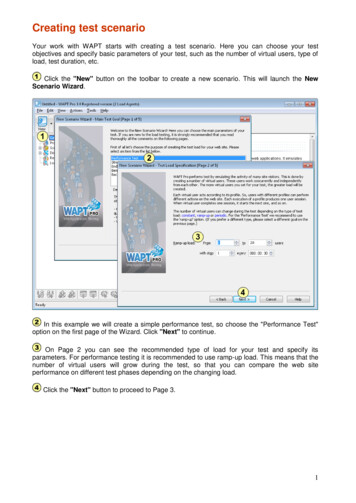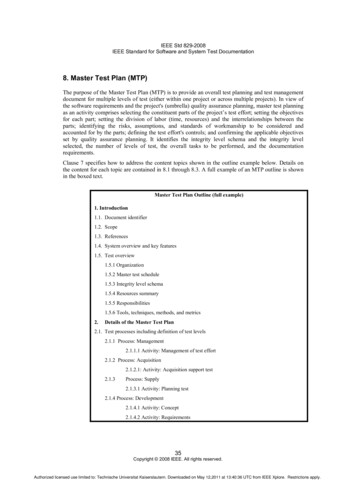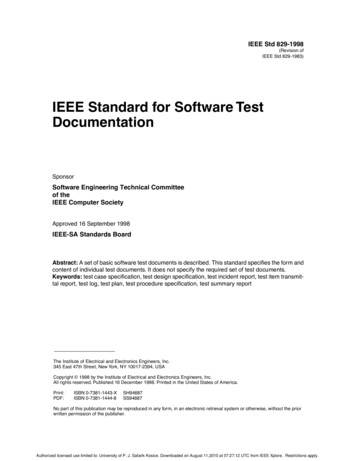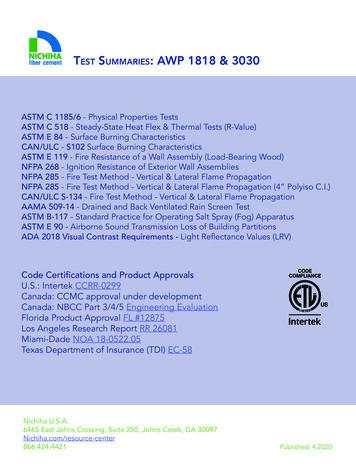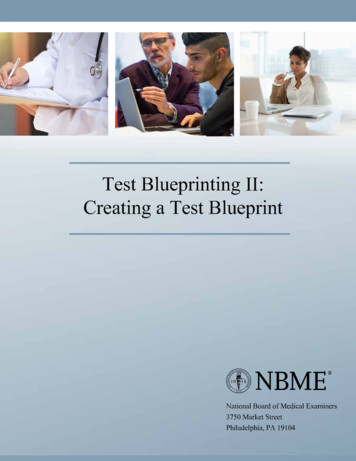
Transcription
Test Blueprinting II:Creating a Test BlueprintNBME National Board of Medical Examiners3750 Market StreetPhiladelphia, PA 19104
Test Blueprinting II:Creating a Test BlueprintCopyright 2019 National Board of Medical Examiners (NBME )
Test Blueprinting II: Creating a Test BlueprintObjectivesBy the end of this lesson, you should be able to:oUnderstand how course content and learning objectives will guide blueprint developmentoDevelop a test blueprint to guide the development of your assessmentsIntroductionConsider yourself in the following scenario. You are preparing an end-of-course exam for yourimmunology course. You want to make sure your students have mastered the important material fromthe course, and you have a bank of 200 multiple-choice questions (MCQ) on immunology topics from acollaborative project with other immunology course instructors. How do you determine which questionsto use on your exam to ensure your test is a high-quality, reliable, and defensible indicator of yourstudents’ knowledge?Creating a test blueprint will help you plan which questions to include in your exam and ensure that itadequately assesses the learning objectives of the course. A test blueprint defines the knowledge andskills you want to assess and will enable you to build purpose-driven, successful assessments. Ablueprint may also help you identify areas where your question pool may be lacking.What is a Test Blueprint?A test blueprint is a list of key components defining your test, including: The purpose of the test: It might be something simple, such as assessing knowledge prior toinstruction to a get a baseline of what students know before taking a course. Alternatively, thetest purpose might be more complex, such as assessing retention of material learned acrossseveral organ-system courses to determine eligibility for advancement. The content framework: Start with the schemas or frameworks commonly used to organize andconsolidate medical knowledge. For example, basic science (e.g., biochemistry, genetics) orclinical science (e.g., surgery, pediatrics) disciplines are common schemas.Test Blueprinting II: Creating a Test Blueprint2
The testing time: This includes amount of testing time available and the need for breaks, as wellas other logistical issues related to the test administration. The content weighting (aka, number of items per content area): The number of questions pertopic category should reflect the importance of the topic; that is, they should correlate with theamount of time spent on that topic in the course. For example, if there are 20 one-hour lectures,there may be 10 questions from each hour of lecture or associated with each hour of expectedstudy. The number of questions per category can be adjusted up or down to better balance theoverall test content and represent the importance of each lecture, as well as the total lecturetime. The item formats (e.g., MCQ, essay question): The item formats should always be appropriatefor the purpose of the assessment.Benefits of Test BlueprintsTest blueprints will help ensure that your tests:oAppropriately assess the instructional objectives of the courseoAppropriately reflect key course goals and objectives – the material to be learnedoInclude the appropriate item formats for the skills being assessedTest blueprints can be used for additional purposes besides test construction:oDemonstrate to students the topics you value, and serve as a study guide for themoFacilitate learning by providing a framework or mental schema for studentsoEnsure consistent coverage of exam content from year to yearoCommunicate course expectations to stakeholders (e.g., trainees, other faculty, administration)Content FrameworksAn outline is one common way to organize a syllabus or plan a lecture. Sometimes, outlines are informaland simply list a few topics; other times, outlines are meticulously detailed with topics and subtopics atmultiple levels arranged in a hierarchical manner. A course outline, along with the following list, canserve as starting points for identifying the content frameworks that will be part of a test blueprint:oTextbook table of contentsoLecture topicsTest Blueprinting II: Creating a Test Blueprint3
oPresentation slidesoPatient casesoLaboratory experimentsoPractice analysisoBehavioral objectivesMedicine provides several schema per content area, so there are often different ways of organizing thesame material inside a given content area. Medical school curricula are frequently organized bydiscipline or by organ system. Another framework is physician skill or competency, which, in contrast tothe discipline and organ system frameworks, focuses on what type of tasks a student should be able toperform. In the following table, every content area within Basic Science also fits into at least oneschema.Table 1. Content Areas Within Schema.Basic ScienceClinical ScienceOrgan SystemPhysician CompetencyBiochemistryInternal MedicineHematopoietic &lymphoreticularInterpersonal & communicationskillsGeneticsSurgeryNervousMedical knowledgePharmacologyPediatricsSkin & connective tissuePatient ed learning &improvementAnatomyObstetrics & GynecologyRespiratorySystems-based practicePhysiologyFamily eurologyGastrointestinalThe following image shows a list of medical frameworks or schemas that could be used in testblueprinting. These schema are arranged in progression from frameworks based on topics to thosebased on practice skills.Test Blueprinting II: Creating a Test Blueprint4
Figure 1. Continuum of Schemas By Knowing/DoingKnowing / Topic orientedAcademic Disciplines and SubdisciplinesOrgan SystemsDisease ClassificationsClinical Presentation or Reason for VisitMedical SpecialtyPhysician CompetencyPhysician Task or Skill DomainDoing / Practice orientedContent WeightingOnce you have identified a framework or schema to organize the test topics, you should consider theimportance of each topic in order to determine the best content weighting for the test as a whole. Thenumber of questions for each content area should reflect the importance of that content area. Thefollowing questions will help you determine the weight of each topic in the assessment:oHow much of your lecture time do you spend teaching this topic in your course?oHow much time are examinees expected to spend studying each topic area independently?oHow much of the course textbook or lab time is devoted to this topic?oHow much of this topic will your students need to know as they move through their training?oWhat other topics should get about the same amount of test time as this topic?The following table shows one example of a blueprint with content weighting. In this example, there isroom for flexibility, that is, some topics have two days of lecture and require five questions, while othershave two days of lecture and require eight questions. This flexibility allows for topics of similarimportance that may contain content of greater complexity.Test Blueprinting II: Creating a Test Blueprint5
Table 2. Content Blueprint for Physiology.Physiology SubtopicLecture Days# of Test QuestionsChemical comp of body13Cell structure & genetic control312Cell respiration & metabolism25Neurons & membrane potentials312The nervous system312Central and autonomic nerv sys14Muscle416Blood & blood clotting28Blood & blood clotting14Cardiovascular system416Respiratory physiology28You are not limited to using only a single framework or schema to plan your test. It is possible tocombine frameworks to form a blueprint matrix. A blueprint matrix allows you to balance contentacross more than one framework. The following table shows a blueprint matrix with cardiovasculardisease topics and physician tasks. The numbers refer to the number of questions in the test that willaddress that content. For example, two questions will assess diagnosis of ischemic heart disease.Table 3. Content Blueprint by Content and Task.Health and Health MaintenanceDiagnosisManagementInfectious and Immunologic211Neoplasm221Dysrhythmias212Heart failure1Cardiovascular ContentIschemic heart disease2211Diseases of myocardium12Vascular disorders12Test Blueprinting II: Creating a Test Blueprint6
Blueprinting Performance AssessmentsThe principles described on the previous screens can also be applied to other types of assessments,including Objective Structured Clinical Examinations (OSCEs). Like a test blueprint, an OSCE blueprint willdefine the purpose of the test, and conditions for sampling, such as the skill being assessed and theorgan system problem presented by the patient. The example OSCE blueprint shown below is organizedby a framework describing communication challenges. Additional case information is provided todescribe the patient’s presenting scenario (the main issue).Table 4. Content Blueprint for ario110 monthsFInformed consentSP encounterChild need lumbar puncture218FCounseling for safe sexSP encounterSexually active teen with herpes335MBehavior changeSP encounterdiagnosisWeight loss445MNon-adherenceSP encounterNon-therapeutic drug levels565MBehavior changeSP encounterSmoking cessation675FDelivering bad news2 SPs (motherDementia diagnosisand daughter)Classifying Test QuestionsTo make creating a test even easier, as you develop and collect test questions or cases, classify themaccording to the same frameworks you use for your blueprint. This will help you find specific materialfrom your pool more efficiently and keep track of needs during the item or case-writing process. Thefollowing table shows some sample test items coded for diagnosis and organ system.Test Blueprinting II: Creating a Test Blueprint7
Table 5. Items Coded by Diagnosis and Organ System.DiagnosisCancer, skin, squamous cellOrgan SystemSkin & connective tissueQuestionA 72-year-old man who is a retired construction workcomes to the physician because of a lesion on his face for3 months. Physical examination shows Cancer, cervicalReproductiveA 42-year-old woman, gravida 2, para 2, comes for aroutine examination. She has a history of vulvarcondylomat acuminata Cancer, lungRespiratoryA 74-year-old man has had confusion for 2 weeks. He hassmoked two packs of cigarettes daily for 50 years Here are some additional ways to classify test material.oAge (e.g., pediatric, adult)oGenderoSite of care (e.g., clinic, emergency department)oDiseaseoPresenting complaintoExaminee level (e.g., end of course, end of year)oTaskPutting It All TogetherBlueprinting can help you:oAssess the instructional objectives of the course or instructional periodoAvoid over- or under-representing a topic in your testoUse appropriate formats for the skills being assessedoShow students the topics you valueTest Blueprinting II: Creating a Test Blueprint8
oEnsure similar exam content from year to yearoCommunicate expectations to other stakeholders (e.g., other faculty, administration)Blueprinting can help students:oConstruct meaning of the content by providing a framework or mental schemaoPlan their studyingoSee the topics you value mostResourcesACGME Outcomes Project & ABMS. (2000). Toolbox of Assessment Methods. Chicago, IL: AccreditationCouncil for Graduate Medical Education and American Board of Medical Specialties.Bartlett, F. C. (1932). Remembering: A Study in Experimental and Social Psychology. Cambridge, England:Cambridge University Press.Boulet, J., & Raymond, M. R. (2013). Blueprinting: Planning Your Tests. FAIMER-Keele Master’s in HealthProfessions Education: Accreditation and Assessment. Lesson 1, Unit 2. London, England: FAIMER Centrefor Distance Learning (CenMEDIC).Downing, S. M., & Haladyna, T. M. (2006). Handbook of Test Development. New York, NY: Routledge.Downing, S. M., & Yudkowsky, R. (2009). Assessment in Health Professions Education. New York, NY:Routledge.McLeod, S. A. (2009). Jean Piaget’s Theory of Cognitive Development. Simply Psychology. RetrievedJanuary 2019 from d, M. R., & Neustel, S. N. (2006). Determining the content of credentialing examinations. In S. M.Downing & T. M. Haladyna (Eds.), Handbook of Test Development (pp. 181–223). Mahwah, NJ: LawrenceErlbaum Associates.Rider, E. A., Nawotniak, R. H., & Smith, G. (2007). A Practical Guide to Assessing the ACGME CoreCompetencies. Marblehead, MA: HCPro, Inc.Test Blueprinting II: Creating a Test Blueprint9
Test Blueprinting II: Creating a Test Blueprint 3 The testing time: This includes amount of testing time available and the need for breaks, as well as other logistical issues related to the test administration. The content weighting (aka, number of items per content area): The number of questions per topic category should re



